FP7-nanoCOPS Developments
Coupled electro-thermal simulation
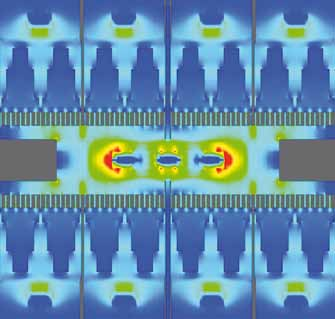 There is a strong dependence between temperature and power in circuits.
High temperatures and extreme power levels are large sources of error.
Until now, two separate operations were needed for the simulation of these
processes. For the first time, nanoCOPS has successfully combined the two
steps into one, speeding up the simulation significantly and delivering much
better results. Among other things, the product ptm-ET from MAGWEL
calculates the computed dynamic currents of Joule self-heating in metal and
active area, heat flow models in chip and package, and supports thermal
planning and non-linear temperature-dependent models. It provides self-consistent solution of electrical and thermal equations in 3D solver. Thanks
to nanoCOPS, MAGWEL now provides a field-solver based with a specification to microelectronics. The uniqueness of ptm-ET is the faithful handling
of nonlinearities that are present in the physical properties of the material
and equations.
There is a strong dependence between temperature and power in circuits.
High temperatures and extreme power levels are large sources of error.
Until now, two separate operations were needed for the simulation of these
processes. For the first time, nanoCOPS has successfully combined the two
steps into one, speeding up the simulation significantly and delivering much
better results. Among other things, the product ptm-ET from MAGWEL
calculates the computed dynamic currents of Joule self-heating in metal and
active area, heat flow models in chip and package, and supports thermal
planning and non-linear temperature-dependent models. It provides self-consistent solution of electrical and thermal equations in 3D solver. Thanks
to nanoCOPS, MAGWEL now provides a field-solver based with a specification to microelectronics. The uniqueness of ptm-ET is the faithful handling
of nonlinearities that are present in the physical properties of the material
and equations.
More information: Wim Schoenmaker, MAGWEL, Wim.Schoenmaker(at)magwel.com
Parametric model order reduction
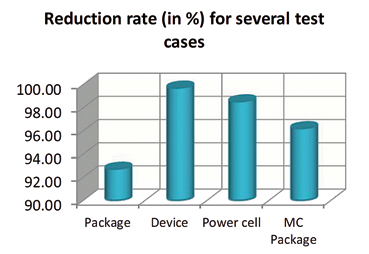 The Max Planck Institute Magdeburg has developed Parametric Model
Order Reduction (PMOR) methods for Electro-Thermal (ET) simulation,
especially for being used together with the simulation tool ptm-ET. These
methods simulate a real and original circuit in a smaller model, which
makes much more extensive simulations possible. The accuracy and efficiency of the proposed PMOR methods are validated by both simulation
and uncertainty quantification based on reduced-order models. A unique
feature is that even temperature-dependent parameters and non-linear,
quadratic functions are integrated into a common simulation.
The Max Planck Institute Magdeburg has developed Parametric Model
Order Reduction (PMOR) methods for Electro-Thermal (ET) simulation,
especially for being used together with the simulation tool ptm-ET. These
methods simulate a real and original circuit in a smaller model, which
makes much more extensive simulations possible. The accuracy and efficiency of the proposed PMOR methods are validated by both simulation
and uncertainty quantification based on reduced-order models. A unique
feature is that even temperature-dependent parameters and non-linear,
quadratic functions are integrated into a common simulation.
More information: Peter Benner, MPI Magdeburg, benner(at)mpi-magdeburg.mpg.de
EM field simulations
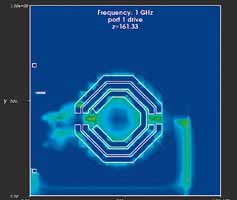 Another theme is the coupling of electromagnetic fields with circuits. This
field is becoming more and more complex. Unlike all previous suppliers
of simulators, the tool developed by nanoCOPS can now simulate not just
individual components in 3D, but also the circuits. Another difference is
that non-linear materials such as semiconductors can be integrated directly
into the simulation. With the MAGWEL program Device-Electro-Magnetic
Modeler (devem), all kinds of disturbance can be simulated. To date, this
graphical approach is unique and allows a much faster detection of errors.
Another theme is the coupling of electromagnetic fields with circuits. This
field is becoming more and more complex. Unlike all previous suppliers
of simulators, the tool developed by nanoCOPS can now simulate not just
individual components in 3D, but also the circuits. Another difference is
that non-linear materials such as semiconductors can be integrated directly
into the simulation. With the MAGWEL program Device-Electro-Magnetic
Modeler (devem), all kinds of disturbance can be simulated. To date, this
graphical approach is unique and allows a much faster detection of errors.
More information:
Wim Schoenmaker, MAGWEL, Wim.Schoenmaker(at)magwel.com
Patrice Barroul, ACCO Semiconductor, Patrice.Barroul(at)acco-semi.com
Test time reduction with new library for uncertainty quantification
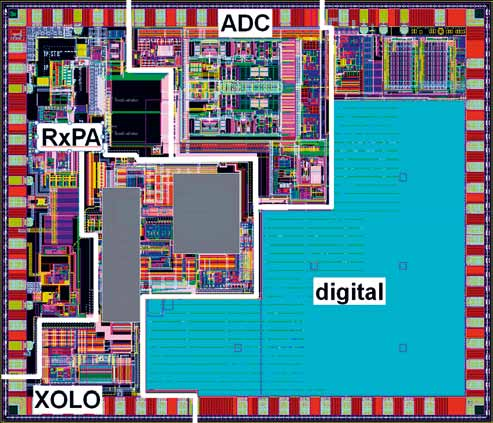 The UQ-library provides uncertainty quantification by creating a response
surface model based on an expansion in orthogonal polynominals. NXP, the
University of Wuppertal and the TU Eindhoven have developed a special
algorithm for fast fault simulation in NXP's in-house circuit simulator. For
this functionality, this simulator is the current market leader. NXP can identify locations on a chip that are probably affected by limited manufacturing
accuracies that cause faulty behaviour at predefined time points for measurements. Inclusion of sensitivity analysis brought accelerations in CPU
time of a factor 20 or more.
The UQ-library provides uncertainty quantification by creating a response
surface model based on an expansion in orthogonal polynominals. NXP, the
University of Wuppertal and the TU Eindhoven have developed a special
algorithm for fast fault simulation in NXP's in-house circuit simulator. For
this functionality, this simulator is the current market leader. NXP can identify locations on a chip that are probably affected by limited manufacturing
accuracies that cause faulty behaviour at predefined time points for measurements. Inclusion of sensitivity analysis brought accelerations in CPU
time of a factor 20 or more.
More information:
Rick Janssen, NXP, rick.janssen(at)nxp.com
Robust topology optimisation
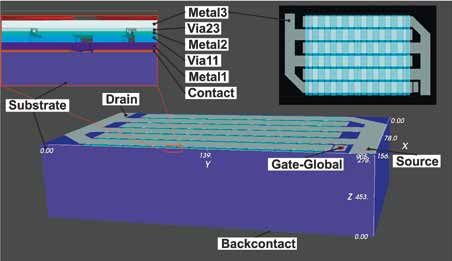 In the manufacture of metal parts, there is inevitably uncertainty and error
involved. In this field, research is about how strongly and in which way the
performance of a transistor is dependent on and affected by this uncertainty. Different voltages cause different structures. This results in very high
temperatures which can lead to the failure of the transistor. For the first
time, the work of nanoCOPS has provided a model that reveals the dangers
and also leads to an improvement of the metal carrier. This allows for a
significant reduction of heat generation.
In the manufacture of metal parts, there is inevitably uncertainty and error
involved. In this field, research is about how strongly and in which way the
performance of a transistor is dependent on and affected by this uncertainty. Different voltages cause different structures. This results in very high
temperatures which can lead to the failure of the transistor. For the first
time, the work of nanoCOPS has provided a model that reveals the dangers
and also leads to an improvement of the metal carrier. This allows for a
significant reduction of heat generation.
More information:
Roland Pulch, University of Greifswald, roland.pulch(at)uni-greifswald.de,
Pjotr Putek, University of Wuppertal, putek(at)math.uni-wuppertal.de,
Jan ter Maten, University of Wuppertal, terMaten(at)math.uni-wuppertal.de
Ageing and failure analysis
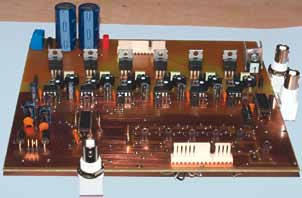 In order to analyse the ageing process, circuit devices and boards are tested
in a temperature cabin at different temperatures ranging up to 180°C. In
order to avoid a destruction of thousands of circuits for testing, new models
have been developed by TU Darmstadt in cooperation with Brno University
of Technology, ON Semiconductors and MAGWEL for test bond wires. The
measurements show that a fused bond wire does not mean an immediate
open loop. Various degradation processes have been intercepted by the
delayed time base feature of the oscilloscopes.
In order to analyse the ageing process, circuit devices and boards are tested
in a temperature cabin at different temperatures ranging up to 180°C. In
order to avoid a destruction of thousands of circuits for testing, new models
have been developed by TU Darmstadt in cooperation with Brno University
of Technology, ON Semiconductors and MAGWEL for test bond wires. The
measurements show that a fused bond wire does not mean an immediate
open loop. Various degradation processes have been intercepted by the
delayed time base feature of the oscilloscopes.
More information:
Roland Pulch, University of Greifswald, roland.pulch(at)uni-greifswald.de,
Pjotr Putek, University of Wuppertal, putek(at)math.uni-wuppertal.de,
Tomas Kratochvil, Brno University of Technology, kratot(at)feec.vutbr.cz,
Sebastian Schöps, TU Darmstadt, schoeps(at)gsc.tu-darmstadt.de
Bond wire model in electrothermal field simulation
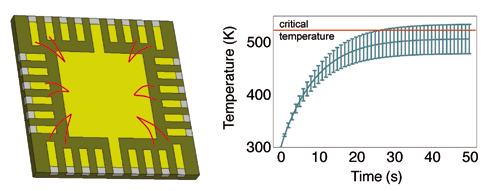 When designing bond wires for the packaging of integrated circuits as
shown in the left Figure, engineers are left with various design parameters. There is a tradeoff between minimal cost and maximum performance. Moreover, the thinner the wire, the higher the probability of failure
(breaking) during operation.
Bond wire calculators allow to estimate parameters based on simplified
models. In nanoCOPS, an improved bond wires (as in title) model was
developed and included in Magwel's electrothermal field simulator. By this,
the overall behaviour of chip and bonding wires can be reliably analysed
in the design phase. It was mathematically shown that the coupled model
preserves important principles such as energy conservation.
Finally, in combination with the tools from uncertainty quantification,
failure probabilities, as shown in the right Figure, can be precisely estimated. Eventually, cheaper and more robust integrated circuits can be
designed.
When designing bond wires for the packaging of integrated circuits as
shown in the left Figure, engineers are left with various design parameters. There is a tradeoff between minimal cost and maximum performance. Moreover, the thinner the wire, the higher the probability of failure
(breaking) during operation.
Bond wire calculators allow to estimate parameters based on simplified
models. In nanoCOPS, an improved bond wires (as in title) model was
developed and included in Magwel's electrothermal field simulator. By this,
the overall behaviour of chip and bonding wires can be reliably analysed
in the design phase. It was mathematically shown that the coupled model
preserves important principles such as energy conservation.
Finally, in combination with the tools from uncertainty quantification,
failure probabilities, as shown in the right Figure, can be precisely estimated. Eventually, cheaper and more robust integrated circuits can be
designed.
More information:
Sebastian Schöps, TU Darmstadt, schoeps(at)gsc.tu-darmstadt.de
Renaud Gillon, ON Semiconductor Belgium, Renaud.Gillon(at)onsemi.com
Wim Schoenmaker, MAGWEL, Wim.Schoenmaker(at)magwel.com
Electromagnetic and thermal netlist extraction from nonlinear field problems
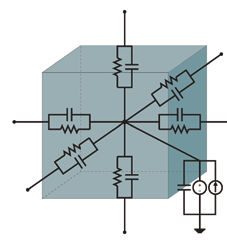 Many field simulations can be carried out efficiently using dedicated tools,
like Magwel's PTM-ET for electrothermal problems. However, some problems require an export of the model, e.g. for additional postprocessing or
coupling to surrounding circuitry.
For those cases, nanoCOPS developed
an algorithm for the lossless extraction of nonlinear equivalent electro-
thermal and electromagnetic netlists
from 3D field models as constructed
by PTM-ET.
In this algorithm, apart from the
spatial discretisation of the fields,
neither simplifications are applied
nor it is limited to particular circuit
simulators.
Many field simulations can be carried out efficiently using dedicated tools,
like Magwel's PTM-ET for electrothermal problems. However, some problems require an export of the model, e.g. for additional postprocessing or
coupling to surrounding circuitry.
For those cases, nanoCOPS developed
an algorithm for the lossless extraction of nonlinear equivalent electro-
thermal and electromagnetic netlists
from 3D field models as constructed
by PTM-ET.
In this algorithm, apart from the
spatial discretisation of the fields,
neither simplifications are applied
nor it is limited to particular circuit
simulators.
More information:
Sebastian Schöps, TU Darmstadt, schoeps(at)gsc.tu-darmstadt.de
Renaud Gillon, ON Semiconductor Belgium, Renaud.Gillon(at)onsemi.com
Wim Schoenmaker, MAGWEL, Wim.Schoenmaker(at)magwel.com
Towards an integrated workflow for uncertainty quantification in semiconductor simulation
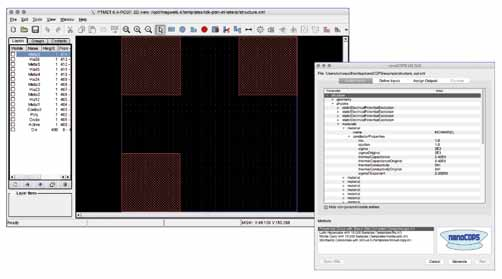 Within the nanoCOPS project, a beta version of a graphical interface was
designed, implemented and added to MAGWEL's software suite. The interface is built upon Sandias Dakota library for uncertainty quatification and
allows an unique user experience: relevant statistical data is gathered and
the impact of tolerances and random distributions of design parameters on
quantities of interest are computed without further user interaction.
To speed up simulations, the hybrid algorithm by Li, Li and Xiu for rare
failure probabilities was implemented and made available to the industrial
partners. The required number of simulations for the quantification is
thereby reduced from several 100,000 to several 100.
Within the nanoCOPS project, a beta version of a graphical interface was
designed, implemented and added to MAGWEL's software suite. The interface is built upon Sandias Dakota library for uncertainty quatification and
allows an unique user experience: relevant statistical data is gathered and
the impact of tolerances and random distributions of design parameters on
quantities of interest are computed without further user interaction.
To speed up simulations, the hybrid algorithm by Li, Li and Xiu for rare
failure probabilities was implemented and made available to the industrial
partners. The required number of simulations for the quantification is
thereby reduced from several 100,000 to several 100.
More information:
Sebastian Schöps, TU Darmstadt, schoeps(at)gsc.tu-darmstadt.de
Wim Schoenmaker, MAGWEL, Wim.Schoenmaker(at)magwel.com
Holistic coupled circuit/electromagnetic field simulation
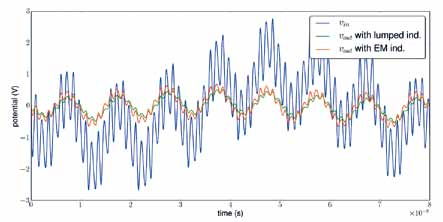 Modular structure of the holistic circuit/electromagnetic field solver PyCEM
The Python integrated Circuit/EM environment PyCEM provides the opportunity to solve coupled circuit and EM equation systems in one holistic
framework. The essential advantage is the robustness of the holistic
approach. The violation of certain contraction conditions may lead to
serious convergence problems in co-simulation approaches. The holistic
approach usually leads to reliable solutions. The holistic approach with
a unified time step control is new and unique for circuit/EM
couplings.
Modular structure of the holistic circuit/electromagnetic field solver PyCEM
The Python integrated Circuit/EM environment PyCEM provides the opportunity to solve coupled circuit and EM equation systems in one holistic
framework. The essential advantage is the robustness of the holistic
approach. The violation of certain contraction conditions may lead to
serious convergence problems in co-simulation approaches. The holistic
approach usually leads to reliable solutions. The holistic approach with
a unified time step control is new and unique for circuit/EM
couplings.
More information:
Caren Tischendorf, HU Berlin, tischendorf(at)math.hu-berlin.de
Multirate circuit simulation incorporating reduced order models
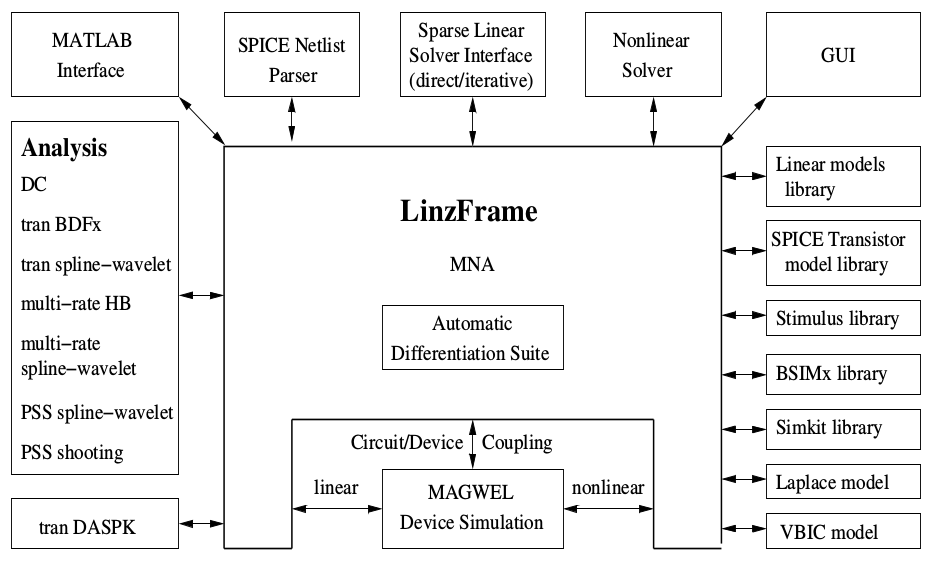 The FHO in-house simulator LinzFrame follows a strict modular concept.
Moreover, it comprises an automatic differentiation suite which simplifies the implementation of new models significantly. It allows that partial
derivatives with respect to the state variables do not need to be coded, but
are computed automatically. Model libraries for linear devices, SPICE tran-
sistor models and a stimulus library including modulated sources, libraries
to industry relevant device models and the Simkit library from NXP are
available. A Laplace model interface, which allows the incorporation of
compressed models from MOR, complements the model libraries.
The FHO in-house simulator LinzFrame follows a strict modular concept.
Moreover, it comprises an automatic differentiation suite which simplifies the implementation of new models significantly. It allows that partial
derivatives with respect to the state variables do not need to be coded, but
are computed automatically. Model libraries for linear devices, SPICE tran-
sistor models and a stimulus library including modulated sources, libraries
to industry relevant device models and the Simkit library from NXP are
available. A Laplace model interface, which allows the incorporation of
compressed models from MOR, complements the model libraries.
The analysis tool comprises standard methods such as DC, AC and transient
analysis with polynomial and trigonometric BDFx (MBDFx) methods, an
interface to the DASPK simulator for solving higher index differential algebraic equations (DAEs), and a spline-wavelet transient simulator. Several
tools for multi-rate simulation Harmonic Balance (HB), BDF and spline-
wavelet techniques are incorporated. Periodic steady state (PSS) methods
for driven and autonomous circuits such as oscillators complete the tool. A
holistic coupling with an EM/device simulator enables mixed-level circuit/
electromagnetic simulation.
More information:
Hans-Georg Brachtendorf, FH Oberösterreich, Campus Hagenberg
hans-georg.brachtendorf(at)fh-hagenberg.at
